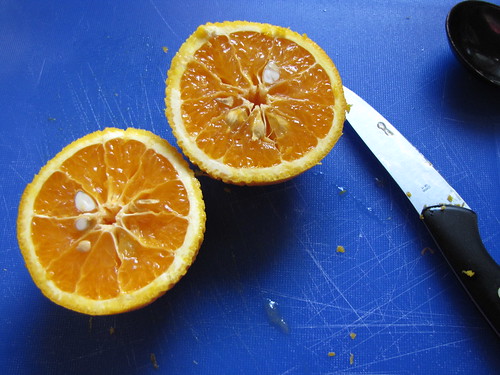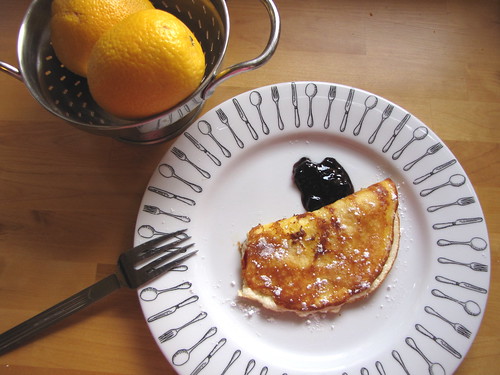The Orange Omelet experiment
I posted about the Orange Omelet recipe yesterday. It’s sweet, uses ingredients that are either on-hand or easily available, and looks relatively easy, so there was no reason not to try it immediately. (I discovered the recipe one day, bought the oranges the next, and made the recipe the day after that. I was on a mission.)
The version of the recipe I chose to use was from The Way to a Man’s Heart: The Settlement Cook Book, Tenth Edition, 1920:
Orange Omelet.
Rind of 1/3 orange,
1 egg,
1 tablespoon orange juice,
2 tablespoons powdered sugar.
Beat the yolk of the egg and add the orange rind and juice. Add the sugar. Fold in the beaten white and turn on heated buttered pan and cook until set. Serve with powdered sugar.
I had eggs and powdered sugar on hand. For the orange, I picked up organic Valencia oranges at Metropolitan Market. (Organic so the orange rind would not have pesticide residue.) Valencias are very sweet, but that doesn’t bother me. I like sweet. This might end up being a dessert omelet… but desserts are lovely things.
Just look at those oranges. Is your mouth watering yet?
I separated the egg yolk and white. Did I mention I’ve never really cooked an omelet before? It was a bit of a gamble. I beat the yolk (“thoroughly,” as one of the older recipes mentioned) and added the orange zest, juice, and sugar. Then I beat the egg white with a milk frother, which was not 100% successful (hint: $1.99 IKEA milk frothers are great with milk, but not so much with anything that has more bulk to it, like egg white), but did eventually get the egg white to a soft peak stage, which seemed acceptable.
I folded the egg white into the yolk mixture, and off it went into the buttered pan. When it set, I put the pan in the oven for two minutes to finish it, then sprinkled it with a tiny bit of sugar, and (from one of the other recipes in yesterday’s post) served it with a spoonful of marionberry jam.
Verdict:
Wow, that is tasty! It is fluffy and airy and orangey and sweet. Just a touch of jam with it is good, but it’s also very good without the jam. It is indeed dessert-level sweet — very much like a sweet crepe. I imagine that a little less sugar or a less-sweet orange would be just fine if you don’t want that sweetness, but I think it’s great as is.
I can’t really imagine why this recipe has been neglected over the last few decades. It’s lovely. I will eat this again.



